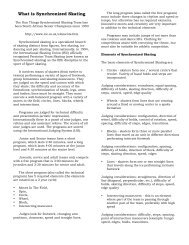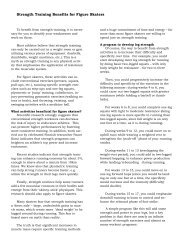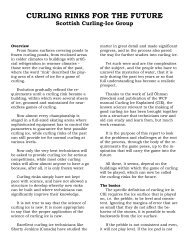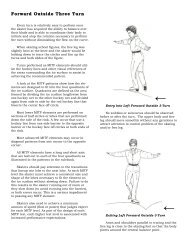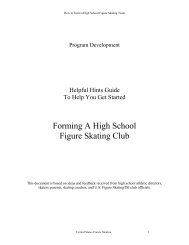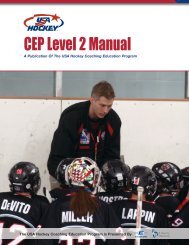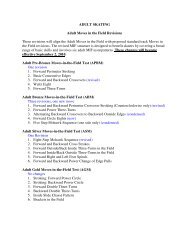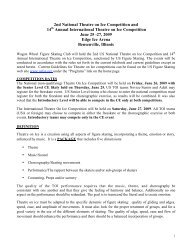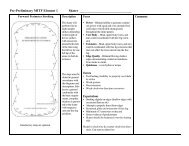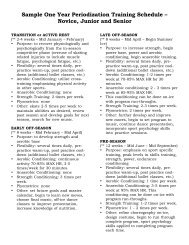CEP Level 3 Manual - Rushmore Hockey Association
CEP Level 3 Manual - Rushmore Hockey Association
CEP Level 3 Manual - Rushmore Hockey Association
Create successful ePaper yourself
Turn your PDF publications into a flip-book with our unique Google optimized e-Paper software.
T A B L E O F C O N T E N T Sbody check is to block the progress of the puckcarrier by legally getting in their way. Too manyplayers and coaches feel that a body check mustknock the opponent down or hard into the boardsevery time. This type of attitude leads tounnecessary rough play and injuries to either of theplayers involved in the collision. The individual wholearns how to block or angle the puck carrier out ofthe play will be much more effective.PRINCIPLES OF BODY CHECKING1. When intending to check in a one-on-onesituation, the velocity of the offensive anddefensive players should be the same. Thiswill prevent the attacking player from skatingaround the defensive player. To play defense,speed in skating backwards is a keyrequirement.2. RHYTHM. The defensive player should betaught to watch the offensive player, to catchthe rhythm and movement of the puckcarrier in order to anticipate his/hermovement. Defensemen should be taught towatch the chest of the opposing playerbecause it is the most difficult part of thehuman body to shift quickly. For instance, aplayer’s legs can maneuver quickly aroundanother player, as can the stick. A good headfake can stymie and outmaneuver a playerquite easily. It is imperative that thedefensive player play the body of the puckcarrier – not the puck.3. ANTICIPATION OF FAKES. A player mustlearn to anticipate the primary and secondarymovements in every fake.4. ABILITY TO ROTATE. The defensive playermust learn to turn quickly both left and righteffectively in order to keep pace. Forexample, a younger player cannot skatebackward as rapidly as a player skatingforward. Therefore, in order to defendagainst a fast forward skater, the defendermay have to start in forward motion, pick upspeed, and then rotate into the backwardposition.5. SELECTION OF POSITION. The primary taskof the defender is to cut off the maindirection of the opposing player to the net bywatching the center movement of the player.When against the boards, the defendershould angle his/her body a half-turn towardthe boards and use the boards to his/heradvantage. A defender may (1) push theplayer off the puck, (2) separate the puckfrom the player by employing a hip check, or(3) pin the player along the boards with asolid body check. The most importantaspect in selecting a checking position toalways make the player move towards theboards by skating at the player from an angle.This cuts off the central ice area.6. COMPULSORY LEG WORK. When thebody check is taking place, most players stopusing their legs. This is a drawback becauseit cuts down the speed along with themomentum of the check. A defender shouldkeep his legs moving at all times.7. QUICKNESS. The defender must learn to cutdown the puck carrier’s reasoning time byattacking suddenly. This comes throughtiming and instinct. For maximum results, aplayer must use his/her stick, shoulder andfull body when checking.SHOULDER CHECKThe shoulder check is most typically used by adefenseman when taking out an on-rushing attacker.The defenseman must anticipate where he/sheintends to make contact with the attacking player,then time his/her backward skating so that contactis made at the appropriate time. An example ofproper shoulder checking technique is illustrated inFigure 1.The defensive player should attempt to aimhis/her shoulder at the offensive player’s chest thenmake contact with the shoulder and side of thebody. Skates must be shoulder width apart with theknees bent to provide a strong foundation. Legpower is used to drive the shoulder into theopponent’s chest. Players may find it helpful to keeponly the top hand on the stick with the free hand up,both for protection and also to push the offensiveplayer. Remember, players are allowed only twosteps before hitting the opponent. There is often atendency to use the elbows in shoulder checking.Do not let your players develop this bad habit.Figure 1. The Shoulder Check.Key Elements• Skates shoulder width apart• Knees bent with the weight on the insideedges of the blade• Head up at all times• Shoulder contact with the opponent’s chest• Stick and elbows down• Two or less steps before hitting the opponentCommon Errors• Defender is skating too slow, thus attackerskates around him/her• Legs are straight, resulting in poor balanceand insufficient power to make a good check• Raising of the arms resulting in elbowingpenalties• Defender is watching the puck, not theplayerHIP CHECKThe hip check is somewhat more difficult toexecute because the timing required is precise. It isimportant to have the offensive player committed toa course which he/she will have difficulty changing(See Figure 2a); this provides a good checkingangle. The defensive player “lines up” the offensiveplayer in a way similar to executing a shouldercheck, but at the last moment the head andshoulders are dropped (bending at the waist) thenthe hip is turned into the stomach area of theoffensive player. The leg closest to the check shouldremain bent. The hips must rotate into the puckcarrier (See Figure 3). This action will result in thedefender being positioned under the attacker,forcing him up and over the defender’s hip (SeeFigure 4). Hip checks may be performed in open iceor along the boards (as indicated in Figures 5 and 6).Figure 2a. Forcing the Offensive Player to aspecific course.Figure 2b. Maintaining a good checking angle.Figure 3. Rotating the Hip.264 | USA <strong>Hockey</strong> Coaching Education Program <strong>Level</strong> 3 <strong>Manual</strong>Defensive Team Tactics | 265



